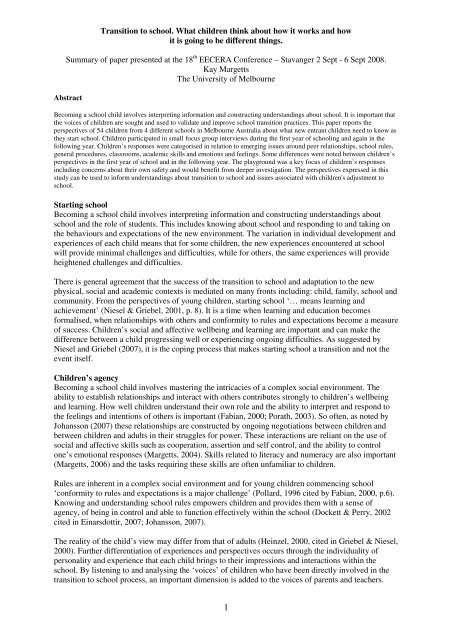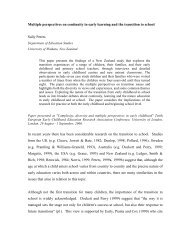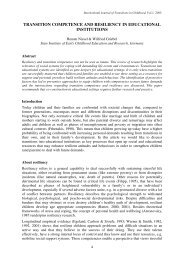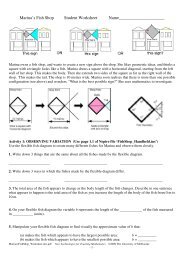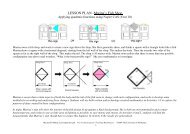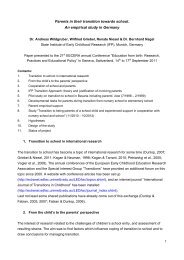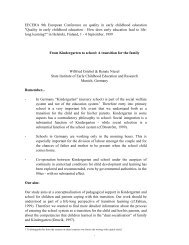Transition to school. What children think about how it works and how ...
Transition to school. What children think about how it works and how ...
Transition to school. What children think about how it works and how ...
Create successful ePaper yourself
Turn your PDF publications into a flip-book with our unique Google optimized e-Paper software.
<strong>Trans<strong>it</strong>ion</strong> <strong>to</strong> <strong>school</strong>. <strong>What</strong> <strong>children</strong> <strong>think</strong> <strong>about</strong> <strong>how</strong> <strong>it</strong> <strong>works</strong> <strong>and</strong> <strong>how</strong><br />
<strong>it</strong> is going <strong>to</strong> be different things.<br />
Summary of paper presented at the 18 th EECERA Conference – Stavanger 2 Sept - 6 Sept 2008.<br />
Kay Margetts<br />
The Univers<strong>it</strong>y of Melbourne<br />
Abstract<br />
Becoming a <strong>school</strong> child involves interpreting information <strong>and</strong> constructing underst<strong>and</strong>ings <strong>about</strong> <strong>school</strong>. It is important that<br />
the voices of <strong>children</strong> are sought <strong>and</strong> used <strong>to</strong> validate <strong>and</strong> improve <strong>school</strong> trans<strong>it</strong>ion practices. This paper reports the<br />
perspectives of 54 <strong>children</strong> from 4 different <strong>school</strong>s in Melbourne Australia <strong>about</strong> what new entrant <strong>children</strong> need <strong>to</strong> know as<br />
they start <strong>school</strong>. Children participated in small focus group interviews during the first year of <strong>school</strong>ing <strong>and</strong> again in the<br />
following year. Children’s responses were categorised in relation <strong>to</strong> emerging issues around peer relationships, <strong>school</strong> rules,<br />
general procedures, classrooms, academic skills <strong>and</strong> emotions <strong>and</strong> feelings. Some differences were noted between <strong>children</strong>’s<br />
perspectives in the first year of <strong>school</strong> <strong>and</strong> in the following year. The playground was a key focus of <strong>children</strong>’s responses<br />
including concerns <strong>about</strong> their own safety <strong>and</strong> would benef<strong>it</strong> from deeper investigation. The perspectives expressed in this<br />
study can be used <strong>to</strong> inform underst<strong>and</strong>ings <strong>about</strong> trans<strong>it</strong>ion <strong>to</strong> <strong>school</strong> <strong>and</strong> issues associated w<strong>it</strong>h <strong>children</strong>'s adjustment <strong>to</strong><br />
<strong>school</strong>.<br />
Starting <strong>school</strong><br />
Becoming a <strong>school</strong> child involves interpreting information <strong>and</strong> constructing underst<strong>and</strong>ings <strong>about</strong><br />
<strong>school</strong> <strong>and</strong> the role of students. This includes knowing <strong>about</strong> <strong>school</strong> <strong>and</strong> responding <strong>to</strong> <strong>and</strong> taking on<br />
the behaviours <strong>and</strong> expectations of the new environment. The variation in individual development <strong>and</strong><br />
experiences of each child means that for some <strong>children</strong>, the new experiences encountered at <strong>school</strong><br />
will provide minimal challenges <strong>and</strong> difficulties, while for others, the same experiences will provide<br />
heightened challenges <strong>and</strong> difficulties.<br />
There is general agreement that the success of the trans<strong>it</strong>ion <strong>to</strong> <strong>school</strong> <strong>and</strong> adaptation <strong>to</strong> the new<br />
physical, social <strong>and</strong> academic contexts is mediated on many fronts including: child, family, <strong>school</strong> <strong>and</strong><br />
commun<strong>it</strong>y. From the perspectives of young <strong>children</strong>, starting <strong>school</strong> ‘… means learning <strong>and</strong><br />
achievement’ (Niesel & Griebel, 2001, p. 8). It is a time when learning <strong>and</strong> education becomes<br />
formalised, when relationships w<strong>it</strong>h others <strong>and</strong> conform<strong>it</strong>y <strong>to</strong> rules <strong>and</strong> expectations become a measure<br />
of success. Children’s social <strong>and</strong> affective wellbeing <strong>and</strong> learning are important <strong>and</strong> can make the<br />
difference between a child progressing well or experiencing ongoing difficulties. As suggested by<br />
Niesel <strong>and</strong> Griebel (2007), <strong>it</strong> is the coping process that makes starting <strong>school</strong> a trans<strong>it</strong>ion <strong>and</strong> not the<br />
event <strong>it</strong>self.<br />
Children’s agency<br />
Becoming a <strong>school</strong> child involves mastering the intricacies of a complex social environment. The<br />
abil<strong>it</strong>y <strong>to</strong> establish relationships <strong>and</strong> interact w<strong>it</strong>h others contributes strongly <strong>to</strong> <strong>children</strong>’s wellbeing<br />
<strong>and</strong> learning. How well <strong>children</strong> underst<strong>and</strong> their own role <strong>and</strong> the abil<strong>it</strong>y <strong>to</strong> interpret <strong>and</strong> respond <strong>to</strong><br />
the feelings <strong>and</strong> intentions of others is important (Fabian, 2000; Porath, 2003). So often, as noted by<br />
Johansson (2007) these relationships are constructed by ongoing negotiations between <strong>children</strong> <strong>and</strong><br />
between <strong>children</strong> <strong>and</strong> adults in their struggles for power. These interactions are reliant on the use of<br />
social <strong>and</strong> affective skills such as cooperation, assertion <strong>and</strong> self control, <strong>and</strong> the abil<strong>it</strong>y <strong>to</strong> control<br />
one’s emotional responses (Margetts, 2004). Skills related <strong>to</strong> l<strong>it</strong>eracy <strong>and</strong> numeracy are also important<br />
(Margetts, 2006) <strong>and</strong> the tasks requiring these skills are often unfamiliar <strong>to</strong> <strong>children</strong>.<br />
Rules are inherent in a complex social environment <strong>and</strong> for young <strong>children</strong> commencing <strong>school</strong><br />
‘conform<strong>it</strong>y <strong>to</strong> rules <strong>and</strong> expectations is a major challenge’ (Pollard, 1996 c<strong>it</strong>ed by Fabian, 2000, p.6).<br />
Knowing <strong>and</strong> underst<strong>and</strong>ing <strong>school</strong> rules empowers <strong>children</strong> <strong>and</strong> provides them w<strong>it</strong>h a sense of<br />
agency, of being in control <strong>and</strong> able <strong>to</strong> function effectively w<strong>it</strong>hin the <strong>school</strong> (Dockett & Perry, 2002<br />
c<strong>it</strong>ed in Einarsdottir, 2007; Johansson, 2007).<br />
The real<strong>it</strong>y of the child’s view may differ from that of adults (Heinzel, 2000, c<strong>it</strong>ed in Griebel & Niesel,<br />
2000). Further differentiation of experiences <strong>and</strong> perspectives occurs through the individual<strong>it</strong>y of<br />
personal<strong>it</strong>y <strong>and</strong> experience that each child brings <strong>to</strong> their impressions <strong>and</strong> interactions w<strong>it</strong>hin the<br />
<strong>school</strong>. By listening <strong>to</strong> <strong>and</strong> analysing the ‘voices’ of <strong>children</strong> who have been directly involved in the<br />
trans<strong>it</strong>ion <strong>to</strong> <strong>school</strong> process, an important dimension is added <strong>to</strong> the voices of parents <strong>and</strong> teachers.<br />
1
The Study<br />
This project investigated the perspectives of <strong>children</strong> in the first year of <strong>school</strong>ing (year prior <strong>to</strong> Year 1<br />
which is known as Prep in Vic<strong>to</strong>ria), <strong>and</strong> one year later (Year 1), <strong>about</strong> what they believed new<br />
<strong>children</strong> commencing <strong>school</strong> need <strong>to</strong> know <strong>about</strong> starting <strong>school</strong>. Responses across the two year levels<br />
were also compared.<br />
Fifty-four <strong>children</strong> participated in this project <strong>and</strong> were drawn from three government primary <strong>school</strong>s<br />
<strong>and</strong> one private <strong>school</strong> in Melbourne Australia. They were first interviewed in the first year of<br />
<strong>school</strong>ing after having attended <strong>school</strong> for seven months. This time frame was chosen as <strong>it</strong> provided<br />
<strong>children</strong> w<strong>it</strong>h time <strong>to</strong> become familiar w<strong>it</strong>h different aspects <strong>and</strong> challenges of <strong>school</strong>ing <strong>and</strong> at the<br />
same time for memories of starting <strong>school</strong> <strong>to</strong> be relatively fresh. Children were interviewed again,<br />
almost 12 months later, when they were in Year 1 of <strong>school</strong> <strong>and</strong> had opportun<strong>it</strong>ies <strong>to</strong> observe the<br />
trans<strong>it</strong>ion <strong>to</strong> <strong>school</strong> of a new group of <strong>children</strong>. Two of the <strong>school</strong>s involved had pre<strong>school</strong>s attached<br />
(a private <strong>and</strong> a government <strong>school</strong>) <strong>and</strong> <strong>school</strong>s comprised families from similar socio-economic <strong>and</strong><br />
cultural backgrounds.<br />
Small focus group interviews were conducted w<strong>it</strong>h <strong>children</strong> mostly in groups of three although there<br />
were two groups of two <strong>children</strong> <strong>and</strong> two groups of four <strong>children</strong>. The use of small focus groups has<br />
been used in previous research by Dockett <strong>and</strong> Perry (1999), Einarsdottir (2003), Peters (2000), <strong>and</strong><br />
Griebel <strong>and</strong> Niesel (2000) in relation <strong>to</strong> <strong>children</strong>’s experiences or expectations of starting <strong>school</strong>.<br />
Interviewing <strong>children</strong> <strong>about</strong> starting <strong>school</strong> acknowledges their agency in their own <strong>school</strong>ing <strong>and</strong><br />
enables their voices <strong>to</strong> be heard among the voices of teachers, parents <strong>and</strong> academics.<br />
Interviews were audio recorded w<strong>it</strong>h <strong>school</strong>, parent <strong>and</strong> child permission. Children were asked simple<br />
questions: firstly – ‘<strong>What</strong> do you <strong>think</strong> new <strong>children</strong> starting <strong>school</strong> need <strong>to</strong> know?’ <strong>and</strong> each child in<br />
the focus groups was given opportun<strong>it</strong>ies <strong>to</strong> contribute ideas. The key questions were chosen as <strong>it</strong> was<br />
believed that by depersonalising the questions <strong>and</strong> creating a s<strong>it</strong>uation where the <strong>children</strong> were<br />
empowered <strong>to</strong> give advice, <strong>children</strong> would be able <strong>to</strong> reflect their own experiences <strong>and</strong> interpretations<br />
of <strong>school</strong> in a non-threatening way.<br />
Audio recordings of each focus group were transcribed <strong>and</strong> analysed independently by the two<br />
interviewers <strong>to</strong> identify emerging or repet<strong>it</strong>ive types of responses <strong>and</strong> <strong>to</strong> validate decisions. Responses<br />
in the first year of <strong>school</strong> (prep) generally related <strong>to</strong> relationships <strong>and</strong> interactions w<strong>it</strong>h others,<br />
procedures, feelings <strong>about</strong> <strong>school</strong>, <strong>and</strong> academic skills. These were categorised in<strong>to</strong> six main themes<br />
relating <strong>to</strong> knowing <strong>about</strong>: peer relationships; <strong>school</strong> rules; general procedures; classrooms; academic<br />
skills; <strong>and</strong> feelings. A smaller category, ‘Other’ included <strong>it</strong>ems not in the main themes. These themes<br />
were used <strong>to</strong> categorise <strong>children</strong>’s responses <strong>to</strong> the interviews in Year 1. If a child provided the same<br />
response more than once or referred <strong>to</strong> the same issue more than once, these were coded only once.<br />
Results<br />
Children’s responses <strong>to</strong> the question ‘<strong>What</strong> do you <strong>think</strong> new <strong>children</strong> starting <strong>school</strong> need <strong>to</strong> know’<br />
resulted in 248 coded responses in the prep year <strong>and</strong> 242 in Year 1. Eighty-eight <strong>and</strong> 128 coded<br />
responses (respectively) were received in response <strong>to</strong> the question, ‘<strong>What</strong> can <strong>school</strong>s do <strong>to</strong> help<br />
<strong>children</strong> who are starting <strong>school</strong>?’ Responses categories are summarised in Table 1 <strong>and</strong> explained in<br />
more detail in the following sub-sections..<br />
A similar number of responses were made in both years <strong>to</strong> the question <strong>about</strong> what new <strong>children</strong> need<br />
<strong>to</strong> know <strong>about</strong> starting <strong>school</strong>. However, there was a 14.5% increase in the number of responses in<br />
Year 1 <strong>about</strong> <strong>how</strong> <strong>school</strong>s can help. This increase may reflect greater knowledge <strong>and</strong> underst<strong>and</strong>ing of<br />
the <strong>school</strong> system.<br />
TABLE 1 Response categories by year level<br />
Prep year Year 1<br />
Response category Number of responses % Number of responses %<br />
Peer Relationships 70 28.2 49 20.2<br />
School Rules 36 14.5 19 7.9<br />
General Procedures 26 10.5 47 19.4<br />
Classrooms <strong>and</strong> Teachers 23 9.2 24 9.9<br />
Emotions/Feelings 14 5.7 16 6.6<br />
Academic Skills 68 27.4 79 32.6<br />
Other 11 4.4 8 3.3<br />
TOTAL 248 242<br />
2
Peer relationships<br />
Responses categorised in relation <strong>to</strong> knowing <strong>about</strong> peer relationships <strong>and</strong> what <strong>school</strong>s can do are<br />
presented in Table 2. While there were fewer responses in this category in Year 1, many were very<br />
similar in both year levels <strong>and</strong> included those associated w<strong>it</strong>h prosocial skills including friendships,<br />
knowing <strong>children</strong>’s names, considering the feelings of others, sharing <strong>and</strong> taking turns. One student in<br />
Prep tellingly noted the importance of <strong>children</strong> being responsible for themselves - (they) have <strong>to</strong> be<br />
responsible for themselves sometimes. Many of the concerns raised <strong>about</strong> relationships were presented<br />
in the context of playground difficulties.<br />
TABLE 2 Knowing <strong>about</strong> peer relationships<br />
Prep year<br />
Year 1<br />
Knowing <strong>about</strong> peer relationships<br />
n % Knowing <strong>about</strong> peer relationships<br />
n %<br />
friendships, being a buddy 24 34.3 friendships, being a buddy 11 22.4<br />
knowing names 5 7.1 knowing names 8 16.3<br />
being nice, not being mean, helping, including 18 25.7 being nice, not being mean, helping, caring, 12 24.5<br />
other, sharing, taking turns<br />
playing <strong>to</strong>gether, manners, sharing<br />
not hurting, being gentle 15 21.4 not hurting, not h<strong>it</strong>ting, not swearing 9 18.4<br />
not bullying, <strong>how</strong> <strong>to</strong> deal w<strong>it</strong>h bullying 7 10.0 not bullying, not bossing, dealing w<strong>it</strong>h bullying 9 18.4<br />
being responsible for one self 1 1.4<br />
70 49<br />
A high number of responses <strong>about</strong> what new <strong>children</strong> need <strong>to</strong> know in the Prep year related <strong>to</strong><br />
friendships – more than double those in Year 1. For example:<br />
In both years, knowing <strong>children</strong>’s names was important for some <strong>children</strong>, <strong>and</strong> this appeared <strong>to</strong> assist<br />
in the establishment <strong>and</strong> cementing of friendships<br />
Knowing who all their <strong>school</strong> friends are…You need <strong>to</strong> know your <strong>school</strong> friends like if you’re<br />
playing you won’t call then different names you have <strong>to</strong> call them their right name (prep)<br />
They have <strong>to</strong> learn their teachers names <strong>and</strong> other people in their class. I was keeping on saying<br />
‘what’s your name?’ (year 1)<br />
The reliance on teachers in the playground appeared <strong>to</strong> be less of an issue for the <strong>children</strong> in Year 1<br />
compared <strong>to</strong> when they were in prep as illustrated in the following examples. This may be a result of<br />
their adaptation <strong>to</strong> the lack of teacher support available in the playground <strong>and</strong> increasing reliance on<br />
<strong>and</strong> confidence in older <strong>children</strong>.<br />
Teachers can help them if they get hurt (prep)<br />
You don’t always have <strong>to</strong> tell on them first thing, you can work <strong>it</strong> out…<strong>and</strong> if they agree you don’t<br />
have <strong>to</strong> tell on them (year 1)<br />
School Rules<br />
Social inst<strong>it</strong>utions usually have a set of clearly articulated rules for protecting members of the group<br />
<strong>and</strong> setting st<strong>and</strong>ards for behaviour. Schools are no exception <strong>and</strong> as noted in Table 3, thirty-six<br />
responses in the prep year <strong>and</strong> nineteen responses in Year 1, related <strong>to</strong> knowing <strong>school</strong> rules,<br />
awareness of consequences, being good (not bad), avoiding or not getting in<strong>to</strong> trouble <strong>and</strong> playing<br />
safely.<br />
TABLE 3 Knowing <strong>about</strong> <strong>school</strong> rules<br />
Prep year<br />
Year 1<br />
Knowing <strong>about</strong> rules<br />
n % Knowing <strong>about</strong> rules<br />
n %<br />
knowing the rules 17 47.2 knowing the rules 16 84.0<br />
consequences of breaking rules 7 19.4 consequences of breaking rules 1 5.2<br />
being good, not being bad, avoiding<br />
trouble<br />
11 30.6 being good, not being bad, 1 5.2<br />
play safely 1 2.8 play safely 1 5.2<br />
36 19<br />
Knowing <strong>and</strong> remembering the <strong>school</strong> rules was referred <strong>to</strong> often <strong>and</strong> difficulties doing this seemed <strong>to</strong><br />
be accepted as a r<strong>it</strong>e of passage as noted in the following examples:<br />
L: Yep, like Bradley he doesn’t know a b<strong>it</strong> of the <strong>school</strong> rules.<br />
E: Yeah, because he’s a new boy. (prep)<br />
They try <strong>to</strong> follow all the rules but they really can’t (year 1)<br />
3
General Procedures<br />
In contrast <strong>to</strong> issues around <strong>school</strong> rules, the number of comments <strong>about</strong> the need for new <strong>children</strong> <strong>to</strong><br />
know <strong>about</strong> general procedures increased in Year 1 compared w<strong>it</strong>h responses in the prep year (see<br />
Table 4). These involved knowing what <strong>to</strong> do (actions), where <strong>to</strong> go (locations), <strong>and</strong> timing of<br />
routines. There was a notable increase in comments <strong>about</strong> uniforms/clothing in Year 1. Procedures<br />
were often rec<strong>it</strong>ed in lists such as:<br />
Hold h<strong>and</strong>s <strong>and</strong> don’t push <strong>and</strong> bring your hat <strong>to</strong> <strong>school</strong> <strong>and</strong> carry your own bags (year 1)<br />
TABLE 4 Knowing <strong>about</strong> <strong>school</strong> procedures<br />
Prep Year<br />
Year 1<br />
Knowing <strong>about</strong> <strong>school</strong> procedures<br />
Knowing <strong>about</strong> <strong>school</strong> procedures<br />
n %<br />
n %<br />
actions – what <strong>to</strong> do, asking for help, lining 12 46.2 actions – what <strong>to</strong> do, asking for help, lining up w<strong>it</strong>h 16 34.0<br />
up w<strong>it</strong>h partner, responding <strong>to</strong> bells, doing<br />
s<strong>how</strong> <strong>and</strong> tell<br />
partner, responding <strong>to</strong> bells, doing s<strong>how</strong> <strong>and</strong> tell<br />
shoe laces 1 3.8 uniform/clothes/shoes 11 23.4<br />
locations – where <strong>to</strong> go, <strong>to</strong>ilet 6 23.1 locations – where <strong>to</strong> go, <strong>to</strong>ilet 11 23.4<br />
time – for lunch, for music, for lining up 4 15.4 time – for lunch, for music, for lining up 2 4.2<br />
<strong>how</strong> <strong>it</strong> <strong>works</strong> 2 7.7 <strong>how</strong> <strong>it</strong> <strong>works</strong> 3 6.4<br />
<strong>how</strong> <strong>it</strong> is different 1 3.8<br />
<strong>to</strong>ilets 3 6.4<br />
underst<strong>and</strong>ing what words mean 1 2.1<br />
26 47<br />
While knowing procedures are similar <strong>to</strong> rules, they were distinguished from <strong>school</strong> rules mainly<br />
because <strong>children</strong> did not refer <strong>to</strong> them as rules.<br />
Classrooms <strong>and</strong> teachers<br />
Another category of responses related <strong>to</strong> knowing <strong>about</strong> classroom procedures including information<br />
<strong>about</strong> the teacher, the classroom <strong>and</strong> <strong>how</strong> <strong>to</strong> behave in the classroom (Table 5). The number of<br />
response in each year level was similar but in Year 1 there was an increased range of responses related<br />
<strong>to</strong> classroom rules <strong>and</strong> procedures.<br />
The <strong>it</strong>ems in Table 5 are self explana<strong>to</strong>ry <strong>and</strong> very close <strong>to</strong> <strong>children</strong>’s own words <strong>and</strong> do not need<br />
repeating as narrative.<br />
TABLE 5 Knowing <strong>about</strong> classrooms <strong>and</strong> teachers<br />
Prep Year<br />
n % Year 1<br />
n %<br />
Knowing <strong>about</strong> classrooms<br />
Knowing <strong>about</strong> classrooms<br />
<strong>about</strong> teacher, teacher’s name 6 26.0 <strong>about</strong> teacher, teacher’s name 5 20.8<br />
what classroom is like 4 17.3 what classroom is like; what class in 2 8.3<br />
listening <strong>to</strong> teacher, doing what teacher<br />
says<br />
5 21.7 listening <strong>to</strong> teacher, doing what teacher says 6 25.0<br />
procedures – being quiet, asking<br />
8 34.7 procedures – being quiet, asking<br />
11 45.8<br />
permission, s<strong>it</strong>ting on mat, crossing legs,<br />
permission, s<strong>it</strong>ting on mat, h<strong>and</strong>s up, s<strong>how</strong><br />
h<strong>and</strong>s up, s<strong>how</strong> <strong>and</strong> tell<br />
<strong>and</strong> tell, speak clearly, pack away/tidy up,<br />
hold pencil correctly, be patient, wa<strong>it</strong> for<br />
teacher before changing classes<br />
23 24<br />
Feelings <strong>and</strong> emotions<br />
Children in both year levels noted that beginning <strong>children</strong> should have pos<strong>it</strong>ive feelings – not be<br />
scared, feel safe (Table 6). Most frequently in prep this involved ‘not feeling scared’ whereas<br />
responses by <strong>children</strong> in Year 1 were more differentiated <strong>and</strong> included being confident. The responses<br />
acknowledge that being scared is a valid feeling as <strong>children</strong> start <strong>school</strong> but that <strong>school</strong>s are really not<br />
scary.<br />
Interestingly, in Year 1 but not in the interviews in the prep year, <strong>children</strong> referred <strong>to</strong> their own<br />
feelings of being worried or nervous when they commenced <strong>school</strong> <strong>and</strong> that <strong>children</strong> starting <strong>school</strong><br />
needed <strong>to</strong> know they might feel like this. Well because they’re nervous <strong>and</strong> because there is so much<br />
rules (year 1).<br />
4
TABLE 6 Knowing <strong>about</strong> feelings<br />
Prep Year<br />
n % Year 1<br />
n %<br />
Knowing <strong>about</strong> feelings<br />
Knowing <strong>about</strong> feelings<br />
not feeling scared 8 57.1 not feeling scared 2 12.5<br />
feeling safe 2 14.3 feeling safe<br />
not being shy 2 14.3 enjoying <strong>school</strong><br />
taking risks 1 7.1 be brave 1 6.2<br />
enjoying <strong>school</strong> 1 7.1 be confident 4 25.0<br />
being worried 6 37.4<br />
being nervous 3 18.7<br />
14 16<br />
Academic skills<br />
Academic skills were referred <strong>to</strong> in 68 responses in the prep year <strong>and</strong> 79 responses one year later. The<br />
spread of responses was very similar from one year <strong>to</strong> the next, w<strong>it</strong>h slight increases in responses<br />
related <strong>to</strong> maths <strong>and</strong> drawing/art in Year 1 as can be seen in Table 7. These skills related <strong>to</strong> learning<br />
generally, <strong>and</strong> also <strong>to</strong> specific domains of learning. Most frequently, responses related <strong>to</strong> l<strong>it</strong>eracy<br />
(wr<strong>it</strong>ing, knowledge of alphabet <strong>and</strong> phonics, reading), followed by maths <strong>and</strong> numeracy, drawing or<br />
doing art, <strong>and</strong> knowing <strong>how</strong> <strong>to</strong> learn or work.<br />
TABLE 7 Knowing <strong>about</strong> academic skills <strong>and</strong> learning<br />
Prep<br />
Year 1<br />
Knowing academic skills<br />
n % Help for academics/learning<br />
n %<br />
wr<strong>it</strong>ing, wr<strong>it</strong>ing own name 24 35.3 wr<strong>it</strong>ing, wr<strong>it</strong>ing own name 28 35.4<br />
reading 15 22.1 reading 15 19.0<br />
alphabet, letter sounds 6 8.9 alphabet, letter sounds 7 8.8<br />
knowing words 3 4.4 knowing words, spelling 4 5.0<br />
maths, numbers 10 14.7 maths, numbers 14 17.7<br />
drawing, doing art 4 5.9 drawing, doing art 7 8.8<br />
knowing <strong>how</strong> <strong>to</strong> learn things, doing hard 6 8.9 knowing <strong>how</strong> <strong>to</strong> learn things, doing hard 4 5.0<br />
work<br />
work, learning <strong>about</strong> the world<br />
68 79<br />
Discussion<br />
Children’s responses <strong>to</strong> the question ‘<strong>What</strong> do new <strong>children</strong> commencing <strong>school</strong> need <strong>to</strong> know <strong>about</strong><br />
starting <strong>school</strong>?’ reflect <strong>and</strong> add <strong>to</strong> current underst<strong>and</strong>ings including the voices of <strong>children</strong>, parents<br />
<strong>and</strong> teachers <strong>about</strong> starting <strong>school</strong>. They add a personal depth not usually evident in the considerations<br />
of adults. The <strong>children</strong> in this study referred <strong>to</strong> the importance of knowing <strong>about</strong> relationships <strong>and</strong><br />
interactions w<strong>it</strong>h others, <strong>school</strong> rules, procedures <strong>and</strong> ways of doing things, classrooms <strong>and</strong> teachers,<br />
feelings, <strong>and</strong> academic skills. Children’s responses support the notion that social, affective <strong>and</strong><br />
learning competencies are important for <strong>children</strong> as they start <strong>school</strong>.<br />
Knowing <strong>about</strong> <strong>how</strong> <strong>to</strong> make friends <strong>and</strong> deal w<strong>it</strong>h interactions including pro-social skills <strong>and</strong> the<br />
abil<strong>it</strong>y <strong>to</strong> deal w<strong>it</strong>h bullying were noted frequently. This supports the findings of Dockett <strong>and</strong> Perry<br />
(1999), Griebel <strong>and</strong> Neisel (2000) <strong>and</strong> Peters (2000) <strong>about</strong> the importance of friends <strong>and</strong> of social<br />
interactions, <strong>and</strong> the suggestion of Johanssen (2007) that relationships at <strong>school</strong> are shaped <strong>and</strong><br />
characterised by negotiation <strong>and</strong> power struggles. Frequent mention of not being hurt, or hurting,<br />
particularly in relation <strong>to</strong> the playground is cause for concern <strong>and</strong> suggests that <strong>children</strong>’s needs for<br />
physical <strong>and</strong> emotional safety are not being sufficiently met.<br />
Children’s suggestions <strong>about</strong> <strong>how</strong> <strong>school</strong> can help w<strong>it</strong>h relationships reflects the recommendation by<br />
Sm<strong>it</strong>h (2003) that <strong>children</strong> need <strong>to</strong> be supported in developing social <strong>and</strong> emotional skills for dealing<br />
w<strong>it</strong>h playground contexts. There is a need for deeper investigations in<strong>to</strong> these issues <strong>and</strong> the impact of<br />
increased presence of teachers in the playground for <strong>children</strong>'s sense of wellbeing <strong>and</strong> competence.<br />
As noted by Dockett <strong>and</strong> Perry (1999), procedural or task rules were important such as <strong>how</strong> <strong>to</strong> line up<br />
or respond <strong>to</strong> bells, or where the <strong>to</strong>ilet was located. Knowing the <strong>school</strong> rules <strong>and</strong> acceptable ways <strong>to</strong><br />
behave appears <strong>to</strong> provide a sense of safety <strong>and</strong> emotional wellbeing.<br />
Knowledge related <strong>to</strong> learning <strong>and</strong> the curriculum was important in both year levels, including <strong>how</strong> <strong>to</strong><br />
learn, <strong>how</strong> <strong>to</strong> do hard work, <strong>and</strong> knowledge related <strong>to</strong> l<strong>it</strong>eracy <strong>and</strong> numeracy. The strong focus by<br />
<strong>children</strong> on the importance of knowing <strong>how</strong> <strong>to</strong> wr<strong>it</strong>e <strong>and</strong> knowing the alphabet <strong>and</strong> letter sounds, along<br />
w<strong>it</strong>h suggestions that teachers could help them sounding letters <strong>and</strong> words, suggest that these skills are<br />
a challenge <strong>to</strong> new entrant <strong>children</strong>. They may also be an important means of measuring one's<br />
competence as a <strong>school</strong> child.<br />
5
There was a high level of consistency in the range of <strong>children</strong>’s responses in the Prep year <strong>and</strong> Year 1<br />
what new <strong>children</strong> starting <strong>school</strong> need <strong>to</strong> know. The decrease in responses <strong>about</strong> <strong>school</strong> rules in Year<br />
1 was counteracted by the increase in responses related <strong>to</strong> general procedures in that year. The<br />
consistency of responses across both interview periods provides evidence for the valid<strong>it</strong>y of <strong>children</strong>’s<br />
perspectives <strong>about</strong> starting <strong>school</strong>. The voices of <strong>children</strong> <strong>about</strong> starting <strong>school</strong> validate the<br />
perspectives of adults, rather than the other way around.<br />
Children's agency in contributing <strong>to</strong> the development of <strong>school</strong> trans<strong>it</strong>ion programs should be<br />
recognised. It is important that the voices of <strong>children</strong> are used <strong>to</strong> inform trans<strong>it</strong>ion programs <strong>and</strong><br />
practices through seeking <strong>and</strong> responding <strong>to</strong> the magn<strong>it</strong>ude of the challenges facing <strong>children</strong> as they<br />
commence <strong>school</strong> <strong>and</strong> their suggestions for <strong>how</strong> <strong>school</strong> can help.<br />
References<br />
Dockett, S. & Perry, B. (1999). Starting <strong>school</strong>: Perspectives from Australia. Paper presented at the Annual<br />
Meeting of the American Educational Research Association, Montreal, April 19-23. EDRS (ED 439 811).<br />
Einarsdottir, J, (2007). Children’s voices on the trans<strong>it</strong>ion from pre<strong>school</strong> <strong>to</strong> primary <strong>school</strong>. In A-W Dunlop & H.<br />
Fabian (Eds). Informing trans<strong>it</strong>ions in the early years. (pp74-91). Berkshire: Open Univers<strong>it</strong>y Press.<br />
Einarsdottir, J, (2003). When the bell rings we have <strong>to</strong> go inside: Pre<strong>school</strong> <strong>children</strong>'s views on the primary <strong>school</strong>.<br />
European Early Childhood Education Research Monograph, 1, 35-49<br />
Fabian, H. (2000). A seamless trans<strong>it</strong>ion. Paper presented at the 10 th European Early Childhood Education Research<br />
Association Conference, London, 29 Aug- 1 Sept. (http:extranet.edfac.<br />
unimelb.edu.au/LED/tec/).<br />
Griebel, W. & Neisel, R. (2000). The <strong>children</strong>'s voice in the complex trans<strong>it</strong>ion in<strong>to</strong> Kindergarten <strong>and</strong> <strong>school</strong>. Paper<br />
presented at the 10 th European Early Childhood Education Research Association Conference, London, 29 Aug-<br />
1 Sept. (http:extranet.edfac.unimelb.edu.au/LED/tec/).<br />
Johannson, I. (2007). Horizontal trans<strong>it</strong>ions: <strong>What</strong> can <strong>it</strong> mean for <strong>children</strong> in the early <strong>school</strong> years?. In A-W<br />
Dunlop & H. Fabian (Eds). Informing trans<strong>it</strong>ions in the early years. (pp. 33-44). Berkshire: Open Univers<strong>it</strong>y<br />
Press.<br />
Margetts, K. (2006 ‘I just got my head muddled up’: Children’s perspectives of starting <strong>school</strong>. Paper presented<br />
at the EECERA 16th Annual Conference Reykjavik, Icel<strong>and</strong>, 30 August – 2 September 2006.<br />
Niesel, R, & Griebel, W. (2007). Enhancing the competence of trans<strong>it</strong>ion systems through co-construction. In A-<br />
W Dunlop & H. Fabian (Eds). Informing trans<strong>it</strong>ions in the early years. (pp. 21-32). Berkshire: Open<br />
Univers<strong>it</strong>y Press.<br />
Niesel, R, & Griebel, W. (2001). <strong>Trans<strong>it</strong>ion</strong> <strong>to</strong> <strong>school</strong>child. <strong>What</strong> <strong>children</strong> tell <strong>about</strong> <strong>school</strong> <strong>and</strong> what they teach<br />
us. Paper presented at the 11 th European Early Childhood Education Research Association Conference,<br />
Alkmaar, Netherl<strong>and</strong>s, 29 Aug - 1 Sept 2001.<br />
Peters, S. (2000). Multiple perspectives on continu<strong>it</strong>y in early learning <strong>and</strong> the trans<strong>it</strong>ion <strong>to</strong> <strong>school</strong>. Paper presented<br />
at the 10 th European Early Childhood Education Research Association Conference, London, 29 Aug- 1 Sept.<br />
(http:extranet.edfac.unimelb.edu.au /LED/tec/).<br />
Porath, M. (2003). Social underst<strong>and</strong>ing in the first years of <strong>school</strong>. Early Childhood Research Quarterly, 18, 468-<br />
84.<br />
Sm<strong>it</strong>h, N. (2003). <strong>Trans<strong>it</strong>ion</strong> form nursery <strong>to</strong> <strong>school</strong> playground: An intervention programme <strong>to</strong> promote emotional<br />
<strong>and</strong> social development. Paper presented at the 13 th European Early Childhood Education Research Association<br />
Conference, Glasgow, 3 Sept- 6 Sept. (http:extranet.edfac.unimelb.edu.au/LED/tec/).<br />
Acknowledgements<br />
This project was funded through the Univers<strong>it</strong>y of Melbourne Early Researcher Grant Scheme. Thanks are given<br />
<strong>to</strong> Caroline Murphy for her assistance w<strong>it</strong>h interviewing <strong>children</strong> <strong>and</strong> transcribing the audio tapes.<br />
6


